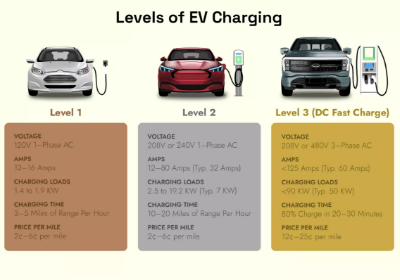Level 2 Charging vs Level 3 Charging – What’s the Difference?
If you own an Electric Vehicle you may have come across the terms level 2 and level 3 chargers when charging your EV. In this article, we explain more on what they mean and what it means for your EV and why you should consider having the EVGateway app
Charging an Electric Vehicle is quite different from the normal fueling of a car as the recharging process is not as quick as adding fuel to your EV. Well as Forbes explains it, there are numerous reasons that affect charging an EV such as different EVs having different input power, having different connectors and the different levels of charging.


Level 2 vs Level 3
The higher the level of charging, the faster the charging process, as more power is delivered to the vehicle. According to Lifewire, a level 2 charger transcends a level 1 charger which offers 120 Volts, while the former offers between 208 Volts and 240 Volts. Level 2 chargers are the most common used chargers and are found in most homes, workplaces and public places. Level 2 Chargers are able to replenish between 12 and 80 miles of range per hour.Level 3 chargers offer 400 Volts and 900 Volts.
Level 3 Chargers are superchargers which can recharge an EV at a rate of 3 to 20 miles of range per minute. Due to the high voltage, they are found in public places and not at homes. The Electric Vehicle Charging Network (EVCN) by EvGateway enables you to locate where such chargers are installed. By having the EvGateway mobile application, drivers are able to monitor the status of their EVs and to also get 24/7 support from different endpoints.
As level 1 charging stations continue to become few, a number of level 2 and level 3 charging stations are being adopted. According to 365pronto, both level 2 and level 3 chargers are installed in public commercial stations. When considering what charger to install it is best to consider different factors such as your driving habits. EvGateway works with different manufacturers to enhance their chargers into smart chargers thus allowing them to be remotely managed and monitored easily.
Advantages of Level 2 Charging stations
Disadvantages of level 2 charging stations
Advantages of Level 3 Charging stations
Disadvantages of level 3 Charging stations
In conclusion, level 3 superchargers may be the solution to your charging needs, but it is worthwhile to consider the downsides too. These charging stations will decrease your battery life in the long run and happen to be more expensive too. A Level 2 charger can be the best solution for most EV owners as they can be installed at home or in different public places.However expect longer charge time of up to 8 hours.
Sources:
https://www.forbes.com/wheels/advice/ev-charging-levels/
https://evgateway.com/
https://www.cars.com/articles/what-is-level-1-2-3-charging-437766/
https://evocharge.com/resources/the-difference-between-level-1-2-ev-chargers/
https://www.lifewire.com/ev-charging-levels-explained-5201716
https://www.365pronto.com/blog/differences-level-1-2-3-ev chargers#:~:text=Level%202%20chargers%20typically%20charge,on%20the%20EV%20charger%20vendor
https://www.vecteezy.com/free-vector/electric-vehicle-charging-station”>Electric Vehicle Charging Station Vectors by Vecteezy
© 2022 EvGateway. All rights reserved